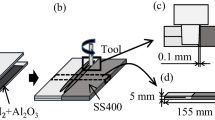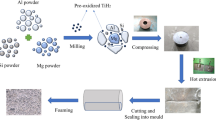Abstract
The use of multi-materials, in which a wide variety of materials are used in the appropriate places, is being promoted to reduce carbon dioxide emissions. In the multi-materialization of automobiles, steel-aluminum joints are widely used. Friction stir welding (FSW) is used for joining steel and aluminum. Because of the solid state and short joining time of the FSW, the thickness of the brittle intermetallic compound layer can be minimized and high-strength joining can be achieved. Meanwhile, since recycling aluminum greatly reduces carbon dioxide emissions compared to the production of new ingots, easy disassembly technology is required. In this study, fabrication of thin foaming agent sheet was attempted. Then, we attempted to realize easy disassembly of steel/aluminum joints by FSW, which can realize strong joints, by using foaming agent sheets that can easily introduce foaming agent on joining interface during FSW. It was shown that foaming agent sheet can be prepared by solidifying foaming agent and pore morphology stabilizer powders using spark plasma sintering. It was also shown that even if a foaming agent sheet was introduced at the joining interface and FSW was performed, good jointing can be achieved. In addition, it was found that the introduction of a foaming agent sheet and foaming at the joining interface can significantly reduce the maximum disassembly load with fracturing at the joining interface. The above results indicate that the use of a foaming agent sheet can easily add an easy-disassembly characteristic to the area near the joining interface in the FSW process.










Similar content being viewed by others
Data availability
The raw/processed data required to reproduce these findings cannot be shared at this time as the data also forms part of an ongoing study.
Code availability
Not applicable.
References
Hirose A (2021) Dissimilar joining for multi-materials structures. J Jpn Inst Light Met 71(4):188–196. https://doi.org/10.2464/jilm.71.188
Nandhakumar R, Venkatesan K (2023) A process parameters review on selective laser melting-based additive manufacturing of single and multi-material: microstructure, physical properties, tribological, and surface roughness. Mater Today Commun 35. https://doi.org/10.1016/j.mtcomm.2023.105538
Nazir A, Gokcekaya O, Billah KMM, Ertugrul O, Jiang JC, Sun JY, Hussain S (2023) Multi-material additive manufacturing: a systematic review of design, properties, applications, challenges, and 3D printing of materials and cellular metamaterials. Mater Des 226. https://doi.org/10.1016/j.matdes.2023.111661
Ostolaza M, Arrizubieta JI, Lamikiz A, Plaza S, Ortega N (2023) Latest developments to manufacture metal matrix composites and functionally graded materials through AM: a state-of-the-art review. Materials 16(4):1746. https://doi.org/10.3390/ma16041746
Wan L, Huang Y (2018) Friction stir welding of dissimilar aluminum alloys and steels: a review. Int J Adv Manuf Technol 99(5):1781–1811. https://doi.org/10.1007/s00170-018-2601-x
Fang Y, Jiang X, Mo D, Zhu D, Luo Z (2019) A review on dissimilar metals’ welding methods and mechanisms with interlayer. Int J Adv Manuf Technol 102(9):2845–2863. https://doi.org/10.1007/s00170-019-03353-6
Mabuwa S, Msomi V (2020) Review on friction stir processed TIG and friction stir welded dissimilar alloy joints. Metals 10(1):142. https://doi.org/10.3390/met10010142
Lambiase F, Balle F, Blaga L-A, Liu F, Amancio-Filho ST (2021) Friction-based processes for hybrid multi-material joining. Compos Struct 266:113828. https://doi.org/10.1016/j.compstruct.2021.113828
Zhao Y, Long Y, Li Z (2022) Research progress of transition layer and filler wire for laser welding of steel and aluminum dissimilar metals. Int J Adv Manuf Technol 119(7):4149–4158. https://doi.org/10.1007/s00170-021-08442-z
Holzschuh GG, Moraes JAR, Garcia SB, Zanesco I, Schneider RDD, Kipper LM (2022) Sustainable applications for disposal of recycled aluminum: a systematic literature review using the SciMAT software. J of Sustain Metall 8(3):945–963. https://doi.org/10.1007/s40831-022-00552-6
Aznar-Sanchez JA, Velasco-Munoz JF, Garcia-Gomez JJ, Lopez-Serrano MJ (2018) The sustainable management of metals: an analysis of global research. Metals 8(10):805. https://doi.org/10.3390/met8100805
Sakurai T (2021) 10 years review of lightweight technology for automotive -summary and future technology. J Jpn Inst Light Met 71(12):569–573. https://doi.org/10.2464/jilm.71.569
Nakazawa Y (2022) Dissimilar metal material joining by mechanical joining. J Jpn Inst Light Met 72(1):31–39. https://doi.org/10.2464/jilm.72.31
Mishra RS, Ma ZY (2005) Friction stir welding and processing. Mater Sci Eng R 50(1–2):1–78. https://doi.org/10.1016/j.mser.2005.07.001
Ma ZY (2008) Friction stir processing technology: a review. metallurgical and materials transactions a-Physical Metallurgy and Materials Science 39 (3):642–658. https://doi.org/10.1007/s11661-007-9459-0
Nandan R, DebRoy T, Bhadeshia H (2008) Recent advances in friction-stir welding - process, weldment structure and properties. Prog Mater Sci 53(6):980–1023. https://doi.org/10.1016/j.pmatsci.2008.05.001
Abbasi M, Bagheri B, Keivani R (2015) Thermal analysis of friction stir welding process and investigation into affective parameters using simulation. J Mech Sci Technol 29(2):861–866. https://doi.org/10.1007/s12206-015-0149-3
Bagheri B, Abbasi M, Abdolahzadeh A, Kokabi AH (2020) Numerical analysis of cooling and joining speed effects on friction stir welding by smoothed particle hydrodynamics (SPH). Arch Appl Mech 90(10):2275–2296. https://doi.org/10.1007/s00419-020-01720-4
Heidarzadeh A, Mironov S, Kaibyshev R, Cam G, Simar A, Gerlich A, Khodabakhshi F, Mostafaei A, Field DP, Robson JD, Deschamps A, Withers PJ (2021) Friction stir welding/processing of metals and alloys: a comprehensive review on microstructural evolution. Prog Mater Sci 117. https://doi.org/10.1016/j.pmatsci.2020.100752
Meng X, Huang Y, Cao J, Shen J, dos Santos JF (2021) Recent progress on control strategies for inherent issues in friction stir welding. Prog Mater Sci 115:100706. https://doi.org/10.1016/j.pmatsci.2020.100706
Abdollahzadeh A, Bagheri B, Abassi M, Kokabi AH, Moghaddam AO (2021) Comparison of the weldability of AA6061-T6 joint under different friction stir welding conditions. J Mater Eng Perform 30(2):1110–1127. https://doi.org/10.1007/s11665-020-05379-4
Abbasi M, Bagheri B, Abdollahzadeh A, Moghaddam AO (2021) A different attempt to improve the formability of aluminum tailor welded blanks (TWB) produced by the FSW. IntJ Mater Form 14(5):1189–1208. https://doi.org/10.1007/s12289-021-01632-w
Yasui T, Tsubaki M, Fukumoto M, Shimoda Y, Ishii T (2006) High-speed weldability between 6063 and S45C by friction stir welding Study of welding of dissimilar metals by friction stir welding (1st report). Weld Int 20(4):284–289. https://doi.org/10.1533/wint.2006.3580
Watanabe T, Takayama H, Yanagisawa A (2006) Joining of aluminum alloy to steel by friction stir welding. J Mater Process Technol 178(1):342–349. https://doi.org/10.1016/j.jmatprotec.2006.04.117
Masuda A, Hangai Y, Mitsugi H, Suzuki R, Matsubara M, Fujii H (2022) Investigation of separation of A1050 aluminum and SS400 steel joined body by foaming. J Jpn Inst Light Met 72(6):366–370. https://doi.org/10.2464/jilm.72.366
Hangai Y, Masuda A, Suzuki R, Aoki Y, Matsubara M, Fujii H (2023) Easy dismantling and separation of friction stir-welded steel and aluminum by foaming. Int J Adv Manuf Technol 126:561–568. https://doi.org/10.1007/s00170-023-11139-0
Masuda A, Hangai Y, Suzuki R, Matsubara M, Aoki Y, Fujii H (2023) Investigation of easy separation of A1050 aluminum / SS400 steel joints using foaming by applying a foaming agent to the joining interface. J Jpn Inst Light Met 73(4):164–166. https://doi.org/10.2464/jilm.73.164
Baumgartner F, Duarte I, Banhart J (2000) Industrialization of powder compact foaming process. Adv Eng Mater 2(4):168–174. https://doi.org/10.1002/(SICI)1527-2648(200004)2:4%3c168::AID-ADEM168%3e3.0.CO;2-O
Kanetake N, Kobashi M (2012) Porous aluminum. J Jpn Inst Light Met 62(3):122–134. https://doi.org/10.2464/jilm.62.122
Hangai Y, Utsunomiya T, Hasegawa M (2010) Effect of tool rotating rate on foaming properties of porous aluminum fabricated by using friction stir processing. J Mater Process Technol 210(2):288–292. https://doi.org/10.1016/j.jmatprotec.2009.09.012
Papantoniou IG, Kyriakopoulou HP, Pantelis DI, Athanasiou-Ioannou A, Manolakos DE (2018) Manufacturing process of AA5083/nano-gamma Al2O3 localized composite metal foam fabricated by friction stir processing route (FSP) and microstructural characterization. J Mater Sci 53(5):3817–3835. https://doi.org/10.1007/s10853-017-1802-2
Papantoniou IG, Kyriakopoulou HP, Pantelis DI, Manolakos DE (2018) Fabrication of MWCNT-reinforced Al composite local foams using friction stir processing route. Int J Adv Manuf Technol 97(1–4):675–686. https://doi.org/10.1007/s00170-018-1964-3
Azizieh M, Goudarzi K, Pourmansouri R, Kafashan H, Balak Z, Kim HS (2018) Influence of friction stir processing parameters on the microstructure of aluminum foams. Trans Indian Inst Met 71(2):483–491. https://doi.org/10.1007/s12666-017-1179-6
Shandley R, Maheshwari S, Siddiquee AN, Mohammed S, Chen DL (2020) Foaming of friction stir processed Al/MgCO3 precursor via flame heating. Materials Research Express 7(2):026515. https://doi.org/10.1088/2053-1591/ab6ef0
Hangai Y, Morohashi H, Aoki Y, Mitsugi H, Fujii H (2022) Process of simultaneously fabricating and foaming precursor using frictional heat generated during friction stir welding. Int J Adv Manuf Technol 121(5–6):3207–3214. https://doi.org/10.1007/s00170-022-09508-2
Abidi MH, Moiduddin K, Siddiquee AN, Mian SH, Mohammed MK (2023) Development of aluminium metal foams via friction stir processing by utilizing MgCO3 precursor. Coatings 13(1):162. https://doi.org/10.3390/coatings13010162
Hangai Y, Takagi T, Koyama S, Suzuki R, Kamakoshi Y (2023) Refoaming of deformed aluminum foam fabricated by precursor foaming process using remaining foaming agent and densification using friction stir welding. Mater Lett 351:135008. https://doi.org/10.1016/j.matlet.2023.135008
Hangai Y, Morita T, Utsunomiya T (2017) Functionally graded aluminum foam consisting of dissimilar aluminum alloys fabricated by sintering and dissolution process. Mater Sci Eng A 696:544–551. https://doi.org/10.1016/j.msea.2017.04.070
Zhou X, Li Y, Chen X (2020) Development of AlMg35-TiH2 composite foaming agent and fabrication of small pore size aluminium foams. J Mater Process Technol 283:116698. https://doi.org/10.1016/j.jmatprotec.2020.116698
Hangai Y, Amagai K, Omachi K, Tsurumi N, Utsunomiya T, Yoshikawa N (2018) Forming of aluminum foam using steel mesh as die during foaming of precursor by optical heating. Opt Laser Technol 108:496–501. https://doi.org/10.1016/j.optlastec.2018.07.016
The-Japan-Institute-of-Light-Metals (1991) Structures and properties of aluminum. The Japan Institute of Light Metals, Tokyo
Banhart J (2001) Manufacture, characterisation and application of cellular metals and metal foams. Prog Mater Sci 46(6):559–632. https://doi.org/10.1016/S0079-6425(00)00002-5
Kobashi M, Noguchi M, Kanetake N (2011) Observation of foaming behavior for rolled sheet precursors made of various aluminum powders. Mater Trans 52(5):934–938. https://doi.org/10.2320/matertrans.L-MZ201113
Duarte I, Vesenjak M, Vide MJ (2019) Automated continuous production line of parts made of metallic foams. Metals 9(5):531. https://doi.org/10.3390/met9050531
Acknowledgements
The authors would like to thank Dr. Yuichiroh Kamakoshi and Ms. Yoshie Aoki, Gunma Industrial Technology Center, for conducting SPS. This work was partly performed under the Cooperative Research Program of Institute for Joining and Welding Research Institute, Osaka University.
Funding
This work was financially supported partly by JST-Mirai Program Grant Number JPMJMI19E5, Japan, JFE21st Century Foundation, and Gunma University for the promotion of scientific research.
Author information
Authors and Affiliations
Contributions
Yoshihiko Hangai: methodology, writing—original draft; Tatsuki Takagi, Takuma Ishigai, Yu Tomita, Shinichi Nishida, Ryosuke Suzuki: investigation, analysis, visualization; Yoshiaki Morisada: methodology, writing—review and editing; Hidetoshi Fujii: supervision, writing—review and editing.
Corresponding author
Ethics declarations
Ethics approval
Not applicable.
Consent to participate
Not applicable.
Consent for publication
Not applicable.
Competing interests
The authors declare no competing interests.
Additional information
Publisher's Note
Springer Nature remains neutral with regard to jurisdictional claims in published maps and institutional affiliations.
Rights and permissions
Springer Nature or its licensor (e.g. a society or other partner) holds exclusive rights to this article under a publishing agreement with the author(s) or other rightsholder(s); author self-archiving of the accepted manuscript version of this article is solely governed by the terms of such publishing agreement and applicable law.
About this article
Cite this article
Hangai, Y., Takagi, T., Ishigai, T. et al. Easy disassembly of steel/aluminum joint by foaming of aluminum part with foaming agent sheet. Int J Adv Manuf Technol (2024). https://doi.org/10.1007/s00170-024-13738-x
Received:
Accepted:
Published:
DOI: https://doi.org/10.1007/s00170-024-13738-x




